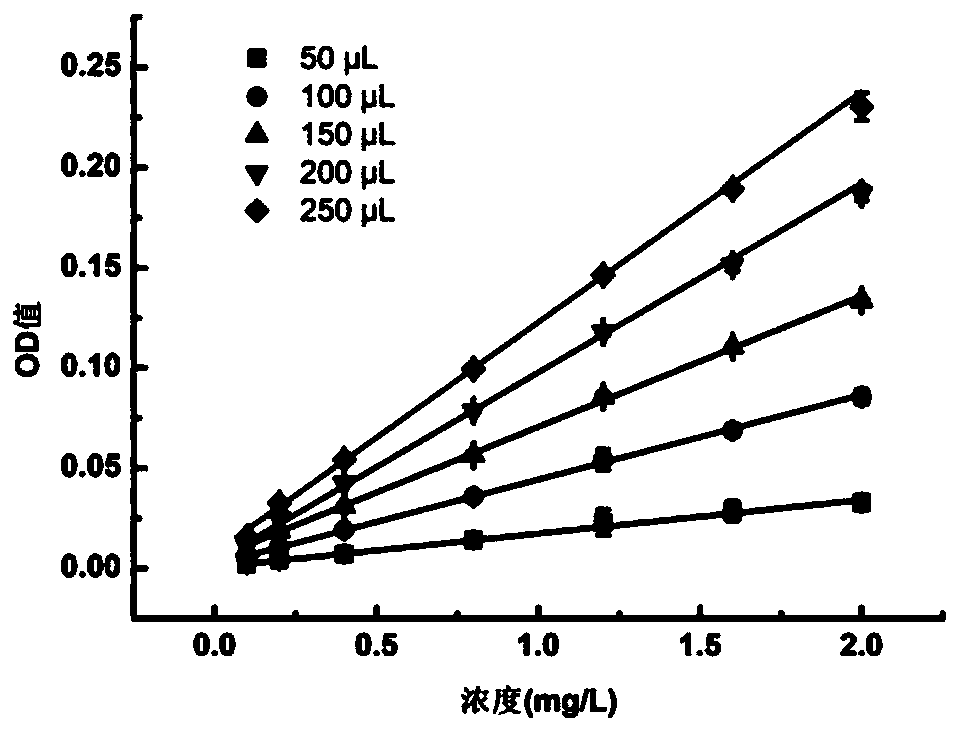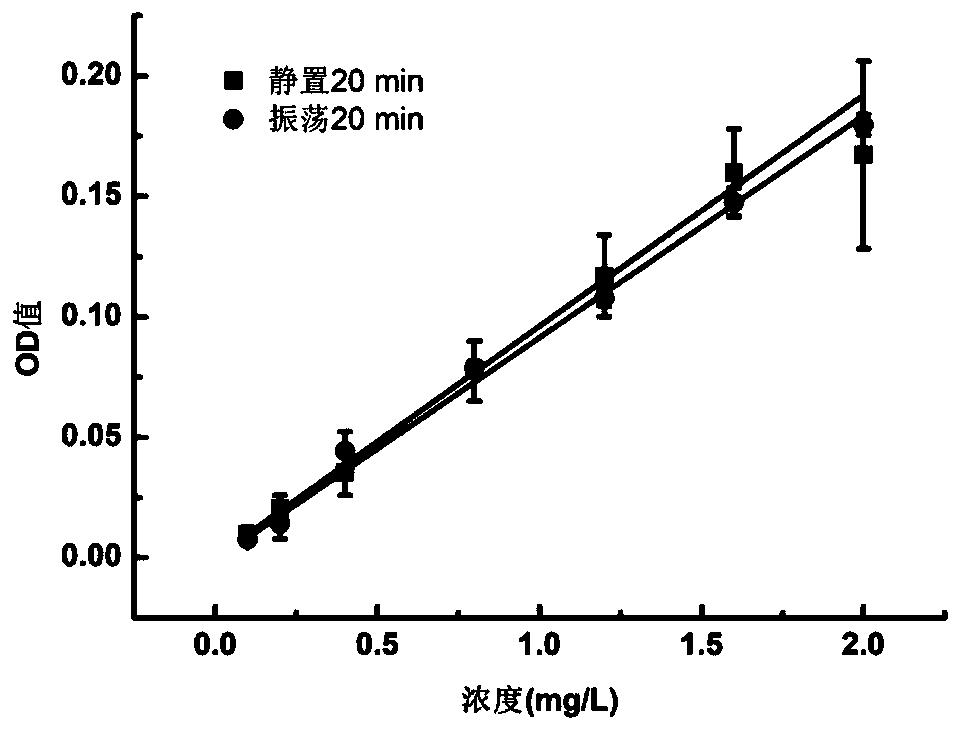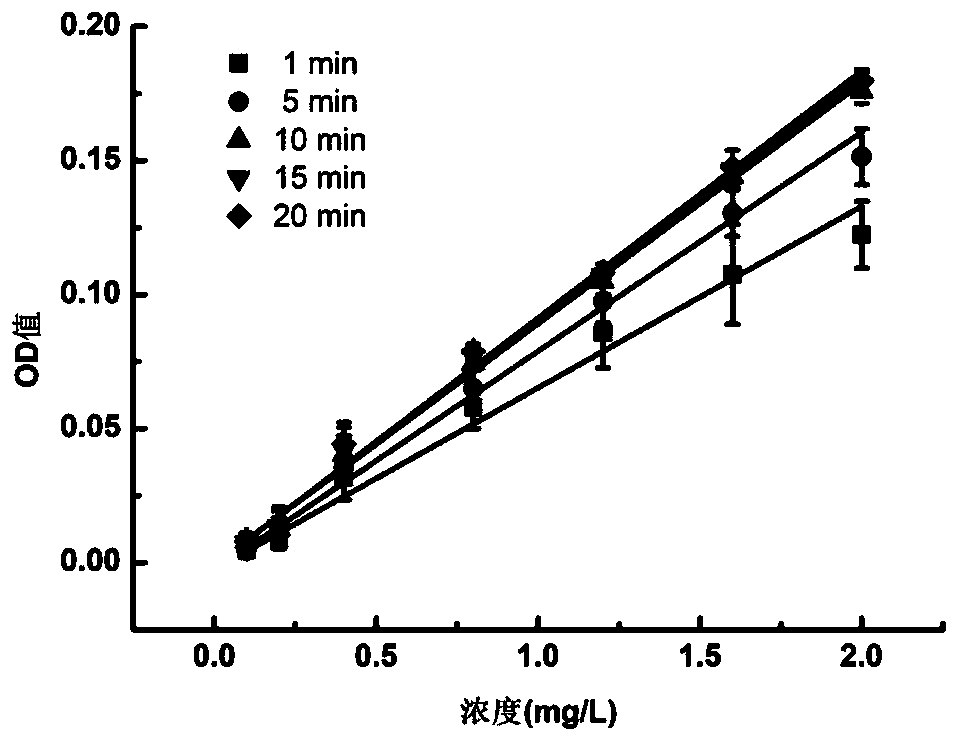Method for rapidly detecting ammonia nitrogen in water on large batches by microplate reader micro-colorimetric method
A microplate reader and colorimetric technology, applied in the field of ammonia nitrogen detection and analysis in water, can solve problems such as few application reports, and achieve the effect of reducing emissions and saving time in analysis and detection work.
- Summary
- Abstract
- Description
- Claims
- Application Information
AI Technical Summary
Problems solved by technology
Method used
Image
Examples
Embodiment 1
[0027] Embodiment 1 standard series preparation
[0028] Spectrophotometric method Pipette 0.00, 0.50, 1.00, 2.00, 4.00, 6.00, 8.00 and 10.00mL ammonia nitrogen standard solution into a 50mL stoppered graduated tube, add water to 50mL. Assays were performed according to standard methods.
[0029] For the micro-colorimetric method of microplate reader, take 0, 2, 4, 8, 16, 24, 32 and 40 μL of ammonia nitrogen standard solution in a 96-well microplate, add water to 200 μL, and the corresponding ammonia nitrogen content is consistent with the spectrophotometric method. When making a standard curve with different sample volumes, pipette the ammonia nitrogen standard solution in proportion.
Embodiment 2
[0030] Embodiment 2 experimental method
[0031] Nessler's reagent spectrophotometric determination adopts the standard method (HJ 535-2009). Add 1.0mL 500g / L potassium sodium tartrate solution, shake well, then add Nessler's reagent 1.0mL, shake well. After standing at room temperature for 10 minutes, use a cuvette with an optical path of 20 mm, and use water as a reference at a wavelength of 420 nm to measure the absorbance.
[0032] Microplate reader microcolorimetric method corresponds to adding 4 μL potassium sodium tartrate solution and 4 μL Nessler’s reagent. After developing color under optimized conditions, measure the optical density (OD) at a wavelength of 420 nm. When making a standard curve with different sample volumes, pipette the sodium potassium tartrate solution and Nessler's reagent in proportion.
[0033] Use the linear range, detection limit, minimum detection limit, precision and sensitivity analysis parameters to optimize the results; the linear range ...
Embodiment 3
[0035] Example 3 Sample volume
[0036] The light source of the microplate reader is transmitted from the bottom of the microwell plate, and the sample volume should cover the bottom of the microwell without overflowing the microwell. The working volume of the Thermo 96-well microplate used in the experiment was 50-250 μL, and 5 sample volume gradients of 50, 100, 150, 200 and 250 μL were set. figure 1 It is the standard curve of the same concentration of ammonia nitrogen standard sequence samples under different sample volume gradients. The correlation coefficients of the curves drawn for different volume samples can reach 0.999. With the increase of sample amount, the optical density of the same concentration sample gradually increased, and the slope of the standard curve also gradually increased. The slope of the standard curve has a more obvious impact on the calculation of the detection value of the standard sample. See Table 1 for the measurement results of the standa...
PUM
 Login to View More
Login to View More Abstract
Description
Claims
Application Information
 Login to View More
Login to View More - R&D
- Intellectual Property
- Life Sciences
- Materials
- Tech Scout
- Unparalleled Data Quality
- Higher Quality Content
- 60% Fewer Hallucinations
Browse by: Latest US Patents, China's latest patents, Technical Efficacy Thesaurus, Application Domain, Technology Topic, Popular Technical Reports.
© 2025 PatSnap. All rights reserved.Legal|Privacy policy|Modern Slavery Act Transparency Statement|Sitemap|About US| Contact US: help@patsnap.com



